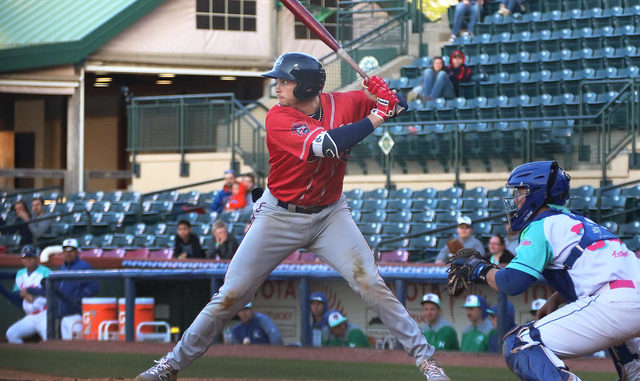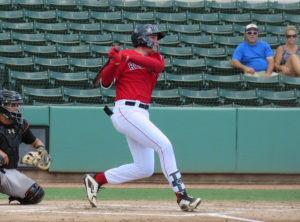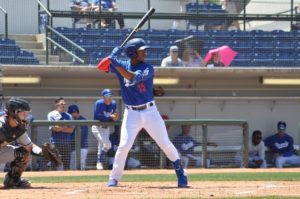
When the Red Sox acquired the trio of Alex Verdugo, Jeter Downs, and Connor Wong from the Dodgers in the Mookie Betts/David Price deal, they infused the organization with a group of young, cost-controllable ballplayers who can all provide upside and play roles on winning teams. Verdugo, a now graduated former top prospect, headlined the return for Boston and (stress-fracture aside) will contribute right away in the big leagues. Hopefully not too far behind, Downs and Wong immediately enhance the team’s overall prospect base, as Downs slots in at No. 2 while Wong debuts at No. 14 in the offseason Top 50 list update from me (@TBDubbs11) and Scott Greene (@Scotty_Ballgame).
It wasn’t without debate that Scott and I slotted Downs in the 2 hole behind incumbent No. 1 ranked Triston Casas. Downs was covered in a thorough overview recently from Prospects1500 co-founder Brian Young (@FakeBaseballGM), which revealed a 3-3 split between Casas and Downs for the No. 1 overall spot in the system when ranked by other top prospect websites. Prospects Live, Fangraphs, and BoSox Injection went with Downs in the top spot, while SoxProspects, MLB.com, and Prospects1500 went with Casas. Let’s look at the debate for the top overall ranking more closely.
The Case for Casas

The first round pedigree (26th overall selection by the Red Sox in 2018), the prodigious power, the all-fields approach is all there for the lefty slugger. Rated as the top power hitter in the Sally League in 2019 by friend of the site John Calvagno (@SALNotes), Casas combines the ability to work the count with some of the finest raw power in the minors. He has a shortened two-strike approach which has limited his K’s for a power hitter (23.6%), and he can still hit it a very long way utilizing the crouch as evidenced here in the clip below.
Red Sox Top Prospect Triston Casas destroyed his 1st HR last night with the Greenville Drive! 💣🚀 pic.twitter.com/RiqPje3NHY
— Boston Strong (@BostonStrong_34) April 11, 2019
Digging a little deeper with Casas, there were some streaks and adjustments along the way during the 2019 season. April through August, his slash lines looked like this:
| Month | Batting Average | On-Base Percentage | Slugging |
| April | .208 | .284 | .364 |
| May | .315 | .396 | .652 |
| June | .279 | .340 | .558 |
| July | .183 | .337 | .317 |
| August | .271 | .374 | .435 |
Despite some lower average months, Casas was able to provide plenty of on-base value and follow up his two weakest months (April/July) with two of his strongest (May/August). Still a young hitter, the lefty platoon splits still exist with a .213/.317/.416 line and 3 of his 20 HR against southpaws. However, the overall .218 ISO, 136 wRC+, and 315.9 ft Est FB distance numbers in Greenville are strong figures that showcase the offensive potential.
The hit tool will reveal itself as Casas continues through the minor leagues, but there is plenty of hope that he will blossom into a serious middle of the order masher with plenty of on-base ability. Even though he has enough arm for 3B, he has made the shift to 1B defensively on a mostly permanent basis this past season and ultimately has a chance to be an above average defender there. Casas’ overall value is still almost exclusively tied into the hit/power outcomes because of the defense, which puts pressure for those two to click together to reach his max ceiling. His left handedness in the box certainly helps provide a little bit of safety as a strong-side platoon bat floor at the very least; but the fact that he is a consensus top 100 prospect at this point reveals optimism around the industry that Casas is a unique kind of 1B only talent to be ranked as he is without proving it above full season Low A ball (he had 2 G at High A in 2019 and should debut there in 2020).
The Case for Downs

Downs also has first round pedigree when he was selected out of high school (32nd overall selection in 2017 by the Cincinnati Reds), and the year edge puts him a full calendar year ahead of Casas. It actually works out to almost a year and a half difference though: Downs’ 289 career minor league games bests Casas 122 by a significant margin, as we recall that Casas suffered a season ending hand injury just 2 games into his professional career in 2018.
To date, Downs has produced as one of the top most power-speed threats in all of minor league baseball. Downs’ 24 HR in 2019 between High A and AA were bolstered by favorable hitting environments, but the Dodgers unlocked some pull side flyball power this past season which is intriguing for a future hitting in the shadows of Fenway’s Green Monster. While Downs has always featured above a 40% pull rate along each professional stop, he was able to cut down his GB rate from 31.7% in 2018 to 24.7% in 2019. Downs’ BA figures were relatively consistent through the season beyond his slow April of .213: .272, .278, .262, .347 across May-August. His on-base ability remained strong throughout the season and culminated with a .362 OBP overall. Downs obliterated LHP to a .337/.414/.621 slash and a 1.035 OPS. One of the strongest features of Downs’ profile is that he provides some thump while balancing a 20% K rate with a double digit BB rate. These figures give optimism that Downs has a higher chance of reaching his hit tool ceiling which projects in the 50-55 FV range.
Downs average speed plays up with high baseball instincts and stolen base ability. Downs has shown progress in his stolen base ability (62% in 2017, 79% in 2018, and 75% in 2019) and should peak in the 10-15 SB range in the majors.
Defensively, Downs should profile as a 2B and can peak at average to above average at the position. Xander Bogaerts has a lock down on SS for the foreseeable future, so Downs should hold down the keystone at the highest level. Red Sox prospects tend to shift to their more permanent defensive home during stints in Portland, and we should expect that Downs plays both SS and 2B in the early going of 2020 to get prospects like Ryan Fitzgerald and others their reps at SS.
Tools Head to Head
If we look at each of the major tools side by side, they play out as follows:
Hit Downs
Downs’ ability to limit K’s and being ahead in his development give us a clearer idea of the present and future hit tool. Downs has shown ample capability against lefties as a right handed hitter, while Casas is presently more susceptible to southpaws.
Power Casas
Casas’ calling card is his power, which is showing in games and to all fields. Downs’ approach skews a bit more pull heavy, but he gets the most of his frame and can leave the yard to the opposite field too (6 HR to the opposite field in 2019).
Run Downs
Casas’ game is centered on what happens in the box, not what happens when he rounds the bases. Downs’ speed may not be a dominant feature of his offensive skillset in the future, but he should keep enough speed to contribute at least double digit steals in the major leagues. His on-base ability helps the likelihood he gets the most opportunities to steal and score runs.
Arm Casas
Casas has enough arm to profile as a 3B, though his size plays better at 1B long term. Downs has enough arm for many plays at SS though likely not full time, and his athleticism and quick release helps the arm play up in the middle infield. These traits should help him as a 2B even more so.
Field Downs
As the Red Sox tend to shift their defenders in Portland to gain the most looks through the minors, the fact that Casas is already 1B only between Greenville and Salem suggests that they really would like to hone his abilities at that position (or more likely, focus on honing the bat). Casas and Downs both have good hands defensively and can blossom into average to above average defenders on the right side of the diamond. Downs gets the edge by holding a more valuable up the middle position.
The Verdict
The tools shake out to be nearly identical, especially since the fielding could end up being a wash if Casas shapes into an above average defender at 1B and Downs peaks as an average 2B. Ultimately, the debate comes down to preference. If you believe that Casas is going to max out on the hit/power and be a huge run producing bat, he’s your top prospect choice. If you believe the breadth of skills for Downs makes him a safer bet and all around player, he’s your top prospect choice. Even though the floor/ceiling numbers are generally the same for both players depending on what site you look on, it seems to be Casas is often attached to “ceiling” while Downs is often attached to “floor.” It’s a perception issue versus an overall baseball production issue.
For me, I like Downs for a few reasons over Casas. I do think that Downs provides a significant amount of upside due to the unique way that he balances power and on-base skills while limiting strikeouts. Even if he doesn’t end up being a huge base stealer, he can contribute enough on the bases where his speed and instincts will show up on first to third opportunities which will ultimately create more run scoring chances. The glove up the middle, where he can chip in at SS and be a long term solution at 2B, provides an excellent path to playing time and a longer leash should offensive troubles arise in the early going (see Pedroia). The fact that Downs is further ahead in his development gives us greater insight to how the hit tool will manifest at the highest level. Downs’ athleticism and smaller frame may wind up holding up better long term side-by-side to Casas. There is great excitement with Casas and rightly so; and even though it’s hard to rank the new guy ahead of the more known Red Sox draftee, Downs is the all-around baseball choice for the Red Sox overall top prospect spot.
Feature Image of Triston Casas, Greenville Drive- Photo credit Regina Rickert.
Ben is an Assistant Editor and also covers the Red Sox and Dynasty/Fantasy baseball content for Prospects1500. He also runs the #2EarlyMiLBMock, an annual prospect-only mock draft, for the Prospects1500 website. Ben is an experienced fantasy baseball player and is a deep league dynasty specialist. He has also contributed at FantraxHQ, RotoFanatic, and retired blogs Real McCoy Minors and Notes from the Sally. Follow Ben on Twitter @TBDubbs11.





Leave a Reply